External water supply and sewage networks: regulatory
Which SNiP on the external water supply and sewerage networks are currently in effect? What are the requirements for designers and installers they impose? What materials are outdoor plumbing constructed from? What are the sewer systems made of? Let's try to answer these questions.
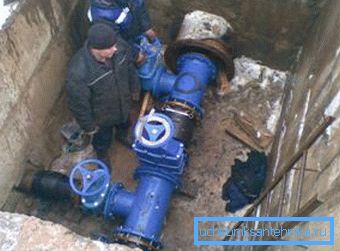
Regulations
In the area of interest to us there are two SNiPs:
- SNiP on the design of external networks of water supply and sewerage number 3.05.04-85.
- SNiP 02.04.02-84, containing requirements for the construction of external water supply.
In addition: there is a separate GOST for the preparation of working drawings of external networks of interest to us. GOST 21.604-84 was put into operation on July 1, 1983 and remains valid to this day.
Let's examine the key requirements of both documents.
SNiP 3.05.04-85
How should the installation of external networks of water supply and sewerage according to SNiP be performed? When moving elements of pipelines with a protective coating, methods of loading and transportation should be used that exclude damage to the coating.
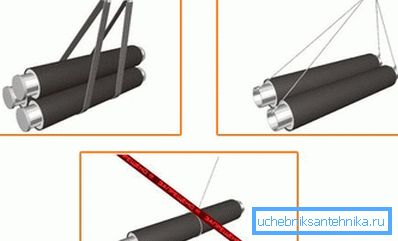
The layout of the pipes in the trench should exclude the ingress of foreign objects into them. Before assembling the pipeline, its elements are inspected from the inside and cleaned of any contamination.
When assembling a non-pressure pipeline from bell-shaped pipes on uneven terrain, they should be laid up with slots up the slope. The instruction is associated with a lower probability of leakage during depressurization of the connection in this case.
The straightness of the pipeline in straight sections is checked visually, for clearance using a mirror.
The maximum permissible deviations from the position of the axes of the pipelines fixed in the project are:
| Type of pipeline | Maximum deviation, mm |
| Pressure head, horizontal deflection | ± 100 |
| Pressure head, vertical deflection | ± 30 |
| Free-flow | ± 5 |
Pressure pipelines can be laid in a gentle arc or curve, subject to two conditions:
- They are mounted from socket pipes with rubber seals..
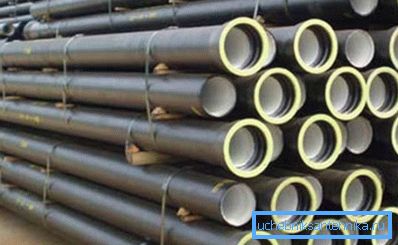
- The angle of rotation on each socket does not exceed 2 angular degrees with a diameter up to 600 mm and 1 angular degree with a diameter over 600 mm.
When minting the sockets, the pipes are centered so that the width of the slot in the socket is the same around the entire circumference.
Welded steel pipes are mounted with a displacement of the weld (straight or spiral) by at least 100 mm. The exception is pipes with a seam boiled inside and out.
External plumbing and sewage networks are laid using cast-iron pipes without rubber seals with sealing of the sockets with a tar or bituminized cable and sealing with asbestos-cement mortar. Similarly, the connection is completed concrete and reinforced concrete pipelines.
However: when assembling a small diameter pipeline with one's own hands, it is much easier to use sanitary silicone sealant for pipes.
SNiP 02.04.02-84
The quality of water supplied for household use should meet all the requirements of GOST 2874-82.
Note: This document is currently terminated. Requirements for water quality are contained in SanPiN 2.1.4.1074-01.

When designing a water supply system, one should proceed from the following water consumption norms:
| House type | Consumption, l / day |
| Bathrooms not available | 160 |
| Bathtubs are installed; DHW is provided by a hot water heater or boiler | 230 |
| Baths are installed, hot water is supplied centrally. | 350 |
Head should not be less than:
- At the entrance to the one-story building - 10 meters.
- At the entrance to the multi-storey building - 10 m + 4 meters on each floor of the building.
- On the street column - 10 meters.
If a multi-storey building is being built in an area with low-rise buildings, it is supplied with its own pumping station.
Sources of water can be:
- Channels, rivers.
- Lakes, ponds and reservoirs.
- Wells.

For industry, the use of treated wastewater is allowed; but to use in the production cycle water that meets the requirements for drinking water supply is prohibited.
Materials
Let's find out what materials a massive construction of external water supply and sewage networks is underway.
Water supply
Cast iron was widely used in the construction of conduits until about the end of the seventies. Then used bell-pipes for chasing; sealing was done with cement locks and lead melt. Modern cast iron pipes are equipped with rubber o-rings and are used where high mechanical strength is needed.
Steel pipes with a fast and technological connection of lashes with welded seams replaced cast iron shortly before the collapse of the USSR. The price of innovation is a sharp drop in resource: repair of external water supply networks due to corrosion and overgrowing of sediments is often required 15-20 years after installation.
For comparison: the cast-iron pipes used in the construction of the famous fountains of Peterhof, have not changed since the commissioning in 1721.
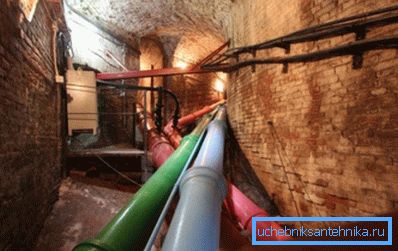
Currently, metal pipes are being replaced by polyethylene pipes. The pressure pipe is connected by low-temperature welding: the ends of adjacent lashes are melted and pressed against each other until the polymer melt solidifies. The minimum lifetime of the solution is estimated at 50 years; the surface of the plastic is not overgrown with sediments and provides extremely low hydraulic resistance.
Sewage
- Traditional cast iron was also noted here: it is to this day that they often carry out the laying of the yard sewage between the wells.
- Reinforced concrete pipes are used, as a rule, in the construction of collectors.
- Ceramics is mainly used in industry for the transport of chemically aggressive and high-temperature effluent.
- Polyvinyl chloride pipe pipes are massively used along with cast iron for laying wastewater systems of small diameter; but for the construction of collectors, in addition to reinforced concrete, are used two-layer pipes with external corrugation, made of polyethylene.
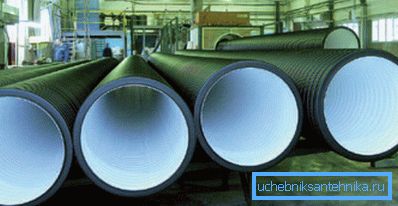
Conclusion
Enumerating the materials, we deliberately omitted many relatively exotic kinds of pipes that the reader will hardly encounter in everyday life. Additional information, as usual, will offer a video in this article. Successes!